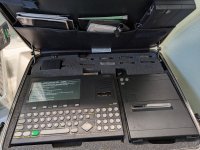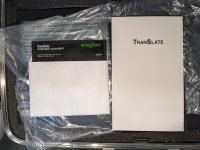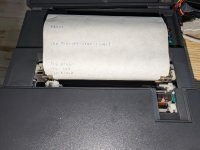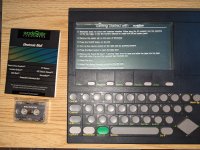ClassicHasClass
Veteran Member
Many folks are familiar with the oddball WorkSlate from Convergent Technologies, which was a 1983 slab portable with a 6800-family CPU where everything is a spreadsheet. It was a commercial failure after seven months and Convergent took millions of dollars in losses on it. A printer/plotter (with the usual Alps mechanism of the time) and a serial/parallel expansion box were made for it, but the expansion box in particular is rather rare.
I've managed to worm my way into the WorkSlate's by using a modified "narrow modular" cord that fits its Peripherals port, where the printer/plotter and expansion box hook up. This is a GPIO port and despite appearances an Ethernet/RJ-45 jack won't fit. We can then hook up serial lines to it and using them send and receive data at 9600 baud using the WorkSlate's built-in terminal. It turns out there are some obnoxious and a couple critical bugs in the firmware ...
On this page are three example applications, a Rock-Paper-Scissors game, a pie charter, and a proxy for a Gopher client. These all work through spreadsheet cells and formulas, the Gopher client in particular by turning Gopher menus into spreadsheets.

 oldvcr.blogspot.com
oldvcr.blogspot.com
The code is on Github, along with a "crossassembler" for the spreadsheet that takes cell data and emits a sheet ready for upload.

 github.com
github.com
Finally, although Bitsavers does have a partial copy of the service manual (hi, Al!), there are no digital copies of the reference guide that I'm aware of and the reference guide is incomplete anyway. I documented all of the spreadsheet built-in functions here with more detailed descriptions, as well as how to hook it up and troubleshooting suggestions.
I've managed to worm my way into the WorkSlate's by using a modified "narrow modular" cord that fits its Peripherals port, where the printer/plotter and expansion box hook up. This is a GPIO port and despite appearances an Ethernet/RJ-45 jack won't fit. We can then hook up serial lines to it and using them send and receive data at 9600 baud using the WorkSlate's built-in terminal. It turns out there are some obnoxious and a couple critical bugs in the firmware ...
On this page are three example applications, a Rock-Paper-Scissors game, a pie charter, and a proxy for a Gopher client. These all work through spreadsheet cells and formulas, the Gopher client in particular by turning Gopher menus into spreadsheets.

Programming the Convergent WorkSlate's spreadsheet microcassette future
In this particular future, we will all use handheld spreadsheets stored on microcassettes, talking to each other via speakerphone, and proba...
The code is on Github, along with a "crossassembler" for the spreadsheet that takes cell data and emits a sheet ready for upload.
GitHub - classilla/workslate: A1="Hello World"+WaitFor("Greatness")
A1="Hello World"+WaitFor("Greatness"). Contribute to classilla/workslate development by creating an account on GitHub.
Finally, although Bitsavers does have a partial copy of the service manual (hi, Al!), there are no digital copies of the reference guide that I'm aware of and the reference guide is incomplete anyway. I documented all of the spreadsheet built-in functions here with more detailed descriptions, as well as how to hook it up and troubleshooting suggestions.






